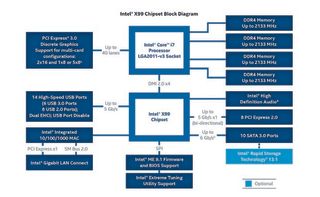Memory Myths: How Much RAM Is Enough?
Don't Forget Your Mother
Processors and chipsets aren’t the only bits of your PC that need to be checked before shelling out for new memory—motherboards are also vital. You’ll need to make sure a board has the right number of slots, and also check what amount and speed of memory it can accept: It’s no good dropping a few hundred bucks on a 32GB 3,000MHz kit if your motherboard taps out at 16GB and 2,666MHz.
There are nuances to be examined, then, but for the most part, the memory landscape is heartening. No matter what processor, chipset, or motherboard you use, you’ll be able to equip a rig with plenty of high-end memory at decent speeds. That’s good for PC building, but it’s not necessarily great news for companies that rely on flogging expensive, high-end kits.
Future developments from Intel and AMD will only improve the situation. Intel’s newly launched architecture, Skylake, supports DDR4 across all of its full-fat desktop chips, but it’ll also be backward-compatible with DDR3, which adds a huge amount of versatility. (Again, pay attention to the number and type of memory slots, as you cannot use DDR3 sticks in a DDR4 slot of vice versa.) We also expect to see improvements to the memory controller and support for larger amounts of memory running at faster speeds.
AMD isn’t standing still, either. Its next proper desktop architecture is called Zen, and it’ll offer full DDR4 support to bring the company’s chips alongside Intel.

The X99 chipset introduced DDR4 to the high-end consumer market, bringing with it faster clock speeds and better power efficiency, but with increased latency.
DDR3 Memory
The first set of DDR3 benchmarks we locked and loaded were PCMark 8’s Home, Creative, and Work tests—a trio of suites that simulate the kind of low-intensity tasks that take place on many systems, from web browsing and video chatting to word processing and spreadsheets.
Our first tests deployed the bare minimum of sluggish DDR3: 8GB of RAM clocked at 1,333MHz. With this RAM, the rig returned scores of 5,170, 6,794, and 5,234 points, in the Home, Creative, and Work tests, respectively. However, with 8GB of 1,600MHz memory deployed, the scores barely improved, with the Creative run only jumping to 6,852.
The biggest gaming news, reviews and hardware deals
Keep up to date with the most important stories and the best deals, as picked by the PC Gamer team.
There wasn’t even much of a difference in these tests when we installed 16GB of 1,866MHz memory: In those three benchmarks, the machine scored 5,270, 6,961, and 5,225. The biggest leap came in the Creative test, which suggests more memory helps with photo editing and other trickier tasks, but it’s hardly a game-changing jump in performance.
We saw similarly modest gains in other photo-related applications. GigaPan Stitch knits together a group of high-resolution photos, and our test image took four minutes and 12 seconds to complete in a rig with 8GB of 1,333MHz memory. That only improved by 11 seconds when we doubled the RAM and upped its speed to 1,866MHz.
Other application benchmarks saw similarly modest impacts. A Cinebench R15 CPU test with two 4GB, 1,600MHz sticks returned a result of 703; doubling the memory and improving its speed to 1,866MHz only improved that figure to 751.
We only saw big improvements in a few benchmarks when running DDR3 tests. In PCMark Vantage, our 8GB 1,600MHz rig scored 18,313 points, but doubling the memory and running it at 1,866MHz saw that result jump by almost 3,000 points—a significant increase.
Indeed, our theoretical tests indicate that improving memory amounts and speeds does make a difference, but that these gains don’t generally translate to real-world tests.
In SiSoft Sandra’s multithreaded bandwidth test, our 2x 4GB 1,333MHz setup scored 16.57GB/s, but doubling the memory and improving its speed to 1,866MHz saw that result jump to 23.33GB/s. There was a decent jump in single-threaded bandwidth, and cache bandwidth also improved significantly when faster memory was added in larger amounts.
The leap from two to four memory sticks doesn’t often have much of an impact on our application tests, either. In Cinebench R15’s OpenGL test, a machine with two 4GB 1,600MHz sticks scored 111 frames per second, with this score only jumping to 117fps with four 4GB 1,600MHz sticks installed.
When running applications using DDR3, then, the differences between slow and fast memory often aren’t huge—and, as long as you’ve got 8GB of memory installed, then you’re going to have enough to get most stuff done in real-world situations.
There was a noticeable performance difference between our rig with 1,333MHz and 1,600MHz memory installed, but, once beyond that 1,600MHz speed, the gaps between different memory speeds narrowed rapidly. We ran GeekBench single-core benchmark on 1,600MHz memory, and then again at 2,800MHz memory, but its result only improved by around 100 points.
The benchmarks demonstrate that there are performance gains to be had by installing more memory at faster speeds, but those gains are only noticeable in high-end applications. For most of us, 8GB or 16GB of 1,866MHz memory will be more than enough.
DDR3 and Gaming
We tested a variety of games using our DDR3 rig, but only found sporadic improvements. In Metro: Last Light, a machine with two 4GB 1,333MHz sticks averaged 126fps, but improving to a pair of 8GB 1,866MHz DIMMs saw that result jump to 144fps. In both Bioshock Infinite and Batman: Arkham Origins, though, the improvements were far less impressive—a few frames better in the minimum frame rate benchmark, and only a gain of 2fps to the average rate.
There also wasn’t much of a difference in any of our Unigine Heaven 4.0 tests. In all of our DDR3 tests—ranging from a system with two 4GB 1,333MHz sticks to a machine with four 8GB 1,600MHz DIMMs—the benchmark’s average frame rate hovered between 63.4fps and 66.8fps. Those configurations didn’t differ much in 3DMark’s Fire Strike test either: in the same range of memory setups, our results only jumped between 11,607 points and 11,635 points, well within the margin of error.

Whether you’ve got DDR3 or DDR4, upping the size or speed of your memory makes little difference to Bioshock Infinite. Crucial’s Ballistix sticks, left, look good, but also come with handy extras, such as integrated thermal sensors.
The DDR4 Difference
Newer DDR4 memory operates with faster speeds, better channel support, and Intel’s latest enthusiast chipset and controller, so we expected our tests to reveal bigger performance disparities. Our initial tests, though, appeared to follow the blueprint already set out by the older DDR3 sticks.
In the Cinebench R15 CPU test, a machine with two 4GB 2,400MHz sticks scored 1,143 points. Doubling the memory and increasing its speed to 3,000MHz, however, only saw that result jump to 1,190. The X264 video encoding test led to similar patterns. Our more modest rig ran through its two tests at 205 frames per second and 68 frames per second, but increasing the memory’s speed to 3,300MHz saw those results only inch forward to 211fps and 73fps—hardly a jump that’ll make a big real-world difference.
GigaPan Stitch’s photo-editing tool only saw a couple of seconds’ worth of improvement with its memory sped up, while Geekbench exhibited similarly small gains: Our first DDR4 rig scored 22,165 points, but doubling the memory to 8GB, running at 2,666MHz, only saw the score jump to 22,849.
It’s a shame because, as with DDR3, theoretical tests illustrated that improving speeds and amounts did make a difference. When we had two 4GB 2,400MHz sticks installed, our test rig delivered 15GB/s and 28.58GB/s of single- and multi-threaded bandwidth, with those numbers jumping to 17GB/s and 32GB/s with those same sticks clocked to 3,300MHz.
Those same benchmarks illustrated how DDR4 copes with quad-channel and larger amounts of memory: Our machine with two 8GB sticks may have delivered 32GB/s of multi-threaded bandwidth, but doubling the memory (and channels) saw that figure leap to 45GB/s. Quad-channel delivered impressive numbers throughout our benchmarks, then, but those figures weren’t always translated to real-world tests. So, we’d say that it’s not a vital addition to your PC, unless you’re keen on buying a Haswell-E system to run intensive work applications or the most demanding games.
Most Popular


